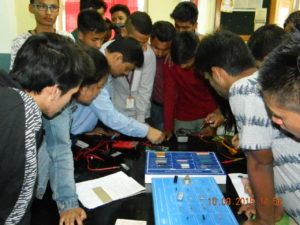April 1982 was an important year for St Edmund’s College, Shillong.
A new Department, the first in the North-eastern region of India, would soon come into existence.
Credit goes to the then Principal, Br M.G.Shannon for his determination in setting up the Department of Electronics.
It would pave the way for similar Departments in educational institutions in the Eastern region – University of Calcutta in 1984 and Guwahati University in 1990, to name a few.

The Beginning
In the 20th century, academics witnessed a breakthrough in Telecommunications with the birth of digital electronics. Because of this, it became imperative to introduce the subject separately.
On how it all began, Prof Wandel Passah says, “I remember how the principal told us that NEHU had offered our college a new subject on the degree level and it was none other than Electronics.”
Considering the excellence of St Edmund’s College, it was no surprise that the University approached them to give it a try.
Electronics was born out of its parent department – Physics.
The first batch of students was small – eight students in all, the majority of whom were Brothers.
Still a new subject, most parents were sceptical of allowing their children to pursue Electronics. Moreover, it did not guarantee job security.
The teachers, Prof. D Bhattacharjee and Prof Passah took upon themselves to run the Department.
Prof Passah says, “We were able to reap the fruits of our labour after three years. The result was fantastic.”
Br Raj Noronha says, “I was in the first batch and delighted that there was a subject like Electronics. I was always passionate about it and had the habit of tinkering with radio.”
He further adds, “In those days there was no internet. There was a lack of study materials. I remember arranging adequate books from Bombay. Materials also came from Calcutta.”
Besides academic hassles, the students faced another issue. Discrete electronic components were not available in Shillong and Guwahati.
As a result, they had to scavenge a lot of record players for example.
Another big drawback – there were less shops specifically catering to electronic components.
Recalling his college days, Br Noronha adds, “I remember that the University had a science exhibition where we won every prize, we were eligible for.”
Dr Dhruba Roy Choudhury, student in the second batch reminiscences on how Electronics was offered as a general subject.
“Our lab used to be in the corridor and part of the Physics department. A corner was given to us.” Dr Choudhury says.
Towards Success
With the ‘Honours Course’ introduced in 1990, the Department gained popularity as students expressed an interest in the subject. Dr Choudhury was part of the syllabus framing.
Before this, the students had to take either Physics or Mathematics as the Honours subject.
Students from the early batches have become successful in their respective fields.
Prof Passah says, “From amongst the boys from outside, Anthony War and Hamarlin Diengdoh were absorbed by the A.I.R. Shillong as technical assistants.”
The rationale behind introducing this subject: to have students as feeders for the M.Sc course at the University level.The long-term plan was to initiate research in this field.
The Department would go on to help Mizoram University set up a separate department of Electronics. One of the faculty members Soumen Chakraborty says, “I remember how our college contributed to the framing of the syllabus.”
What Now?
With the quality of the Electronics Department lab improving, students come from all regions of North-East India.
Students from Nagaland and Manipur, for instance,are gradually opting for Electronics as their subject of choice.
The challenge that remains now is awareness on what makes this subject tick.
Dr Choudhury adds how Electronics needs to be a part of the syllabus right from the high school level. Students tend to go for Physics. The need of the hour is to tell them about the subject.
“It is a practical difficulty we face during admission,” he says.
That said, the journey of this Department is inspiring for educationists with a vision.



